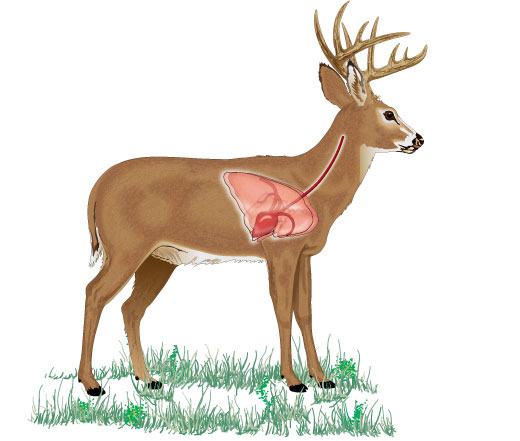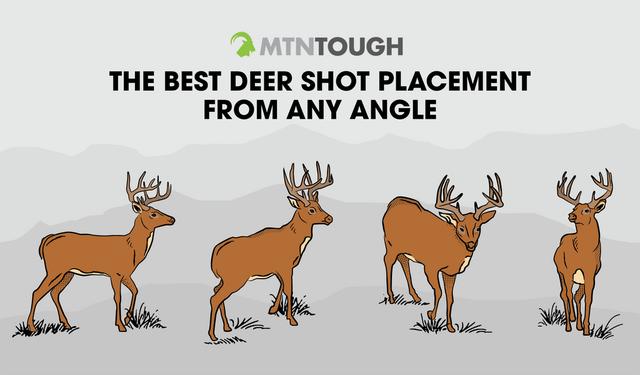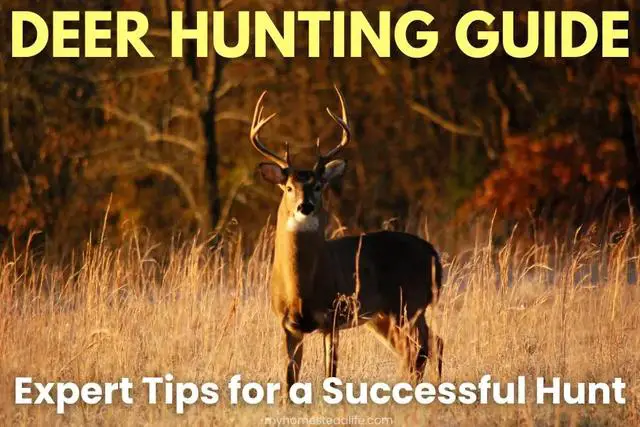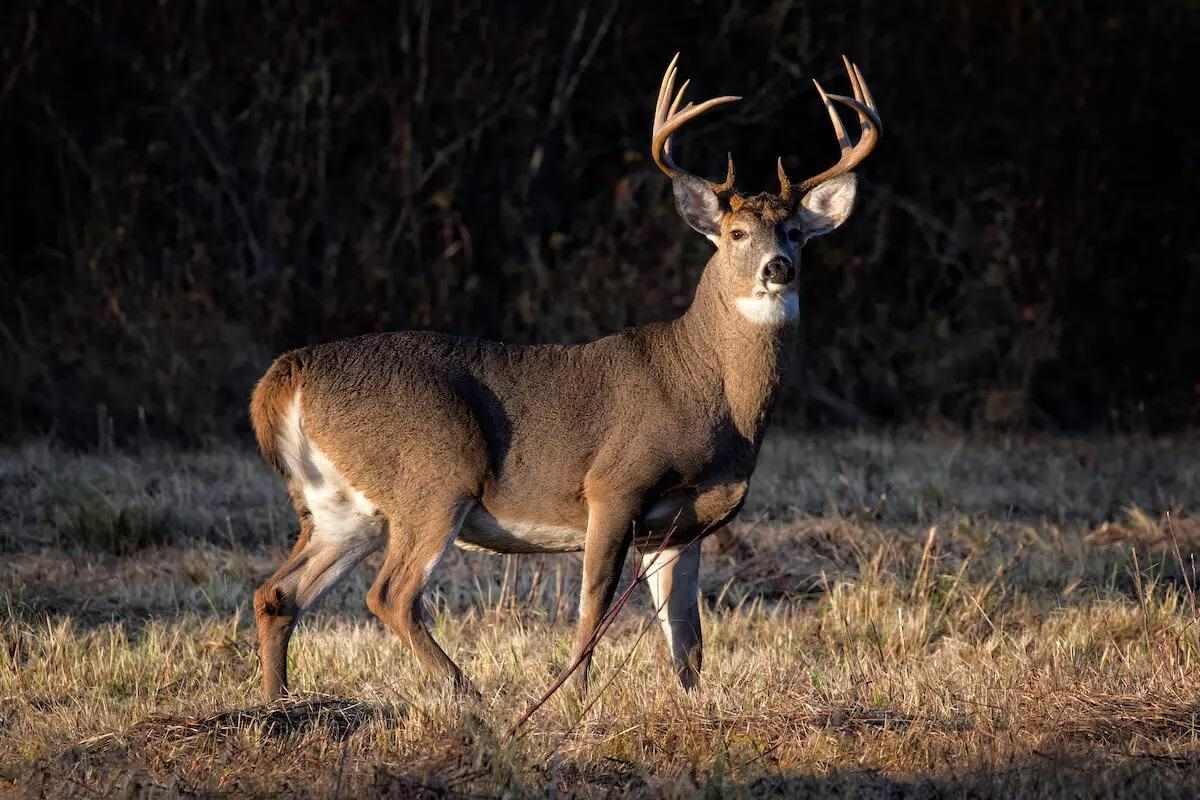“Mastering the art of deer hunting: Learn effective strategies and techniques to ethically and skillfully bring down a deer. Gain insights into ideal equipment, tracking methods, and responsible hunting practices to ensure a successful and humane kill.”
1. Mastering the Art of Deer Hunting: How to Make a Clean and Humane Kill

Deer hunting is a popular activity for both experienced hunters and novices alike. Not only does it provide an opportunity to source lean animal protein, but it also allows individuals to connect with nature and enjoy the thrill of the hunt. However, it is important to approach deer hunting with respect for the animal and strive to make each kill as quick and humane as possible.
When it comes to hunting deer, there are various weapons that can be used, including rifles, shotguns, and bows. Rifles are commonly used, with calibers ranging from.243 up to 30-.06 or 30-30 being suitable for most deer encounters. Shotguns can also be used with deer slugs, although they are less common. Bow hunting is another popular method, with a draw weight limit of around 45 pounds in most areas.
Before heading out on a hunt, it is crucial to ensure that you have the necessary permits and permissions from local authorities or landowners. Hunting on private property may require obtaining permission from the landowner beforehand. Additionally, taking safety precautions such as informing someone of your whereabouts and avoiding alcohol consumption or eating fatty foods before hunting can contribute to a successful and safe experience.
To increase your chances of spotting deer, look out for food sources such as apples or cornfields where deer are likely to congregate. Water sources also attract deer, so keep an eye out for those as well. Ideally, a field with a diameter of around 60 yards would be suitable for hunting deer. However, if you have a longer range rifle with an accurate scope, a larger meadow of approximately 300 yards in length would be desirable.
When it comes to shooting at a deer, it is important to aim for vital areas such as behind the front leg about 5-7 inches up from the chest. This shot is likely to penetrate the heart and lungs, although it may not always result in an immediate kill. Another lethal spot to aim for is the neck, through the spine, just behind the jawline of a deer showing its broadside. However, this shot may paralyze the deer and require a second shot or throat slit to finish the job.
Safety should always be a top priority when hunting, so be aware of your surroundings and avoid shooting towards any person, private residence, public road, or other areas where shooting would be unsafe. It is also important to remember the general spot where you made the hit and the direction in which the deer ran off. Marking the spot on your GPS can be helpful for tracking purposes.
If you miss your shot and notice thin blood or bile on the ground, it indicates that you will need to track the wounded deer quickly for a more humane kill. Some hunters use hydrogen peroxide sprayed around foliage to make blood more visible if it proves difficult to spot. When approaching a wounded deer, exercise extreme caution as injured animals can be dangerous. A well-sharpened hunting knife is essential for field dressing and ensuring that you have all necessary tools before heading out on a hunt.
By following these guidelines and practicing ethical hunting methods, you can master the art of deer hunting while ensuring clean and humane kills. Always prioritize safety, respect for nature, and responsible hunting practices for an enjoyable experience in the great outdoors.
2. The Ultimate Guide to Killing a Deer: Tips for Accuracy and Safety

Choosing the Right Weapon
When hunting deer, it’s important to choose the right weapon for the job. Many different rifles are used for deer hunting, ranging from a.243 up to a 30-.06 or 30-30 caliber. These rifles are more than capable of taking down a deer effectively. Shotguns can also be used for deer hunting, with deer slugs available specifically for this purpose. Bow hunting is another popular method, with a typical draw weight limit of 45 pounds in most areas.
Preparing Yourself and Your Gear
Before heading out to hunt, it’s important to prepare yourself and your gear properly. Make sure you have all the necessary licenses and permits required by your local Department of National Resources. It’s also crucial to wear blaze orange clothing to ensure visibility and safety among other hunters in the area.
To avoid alerting deer with strong smells, refrain from drinking alcohol or eating fatty foods the night before hunting. Store your jackets and clothing in Rubbermaid containers with spruce bows to make them smell like the woods. Some hunters even layer baking soda between their clothing layers to further mask their scent.
Finding the Right Hunting Spot
Finding a suitable hunting spot is essential for success in deer hunting. Look for areas with deer-friendly food sources such as apples or corn, as well as available water sources where deer are likely to congregate. Ideally, a field about 60 yards in diameter would be perfect for hunting deer, but if you have a longer-range rifle with an accurate scope, a larger meadow of around 300 yards long would be desirable.
If possible, hunt on private property with permission from landowners. Always let someone else know where you’re going hunting and when you’re expected to return, especially if you’ll be out of cellphone range. Safety should always be a top priority.
Mastering Your Shooting Technique
To make an accurate and humane shot, it’s important to master your shooting technique. There are different positions you can use, such as standing, kneeling, or sitting. When standing, maintain a stable stance with your feet shoulder-width apart and your body relaxed. If you choose to kneel, support your elbow with your knee or thigh to improve aim stability. In the sitting position, sit cross-legged perpendicular to your target with the knee of your non-shooting hand pointing towards the target.
Aiming for the Kill Shot
When aiming for a deer, there are specific spots that are more likely to result in an effective kill. The most popular spot is behind the front leg, about 5-7 inches up from the chest. This shot will penetrate the heart and lungs but may not immediately bring down the deer. Another lethal spot is through the neck and spine by aiming just behind the jawline of a broadside deer.
It’s crucial to be aware of your surroundings when taking a shot and ensure there are no people, private residences, public roads, or other areas where shooting would be unsafe.
Tracking and Approaching Wounded Deer
After making a shot on a deer, it’s important to track its blood trail carefully. Thin blood or bile on the ground indicates a missed shot that requires quick tracking for a more humane kill. Some hunters use hydrogen peroxide sprayed around foliage to make blood more visible.
Approaching a wounded deer should be done cautiously and with extreme care. If the deer is still alive but doesn’t seem close to death, take another accurate shot through its brain or chest to put it down quickly. Some hunters prefer using a knife to slit the deer’s throat for bleeding out, but be aware of the potential danger posed by an injured deer with antlers.
Remember to always prioritize safety and follow local hunting regulations and guidelines. Happy hunting!
3. Hunting Deer: The Best Techniques for Making a Quick and Ethical Kill
Choosing the Right Weapon
When hunting deer, it’s important to choose the right weapon for the job. Many different rifles can be used, ranging from a.243 up to a 30-.06 or 30-30 caliber. These rifles are suitable for any deer you’re likely to encounter. Shotguns can also be used for hunting deer, with deer slugs available specifically for this purpose. Bow hunting is another popular method, with a legal limit of 45 pounds draw weight in most areas.
Selecting the Hunting Location
Finding the right hunting location is crucial for a successful deer hunt. Look for areas with deer-friendly food sources such as apples or corn, as well as available water sources where deer are likely to congregate. Ideally, a field about 60 yards in diameter would be perfect for hunting deer. If you have a longer range rifle with an accurate scope, a larger meadow of around 300 yards long would be desirable.
Taking Precautions and Preparing Yourself
Before heading out to hunt, there are several precautions you should take and preparations you should make. Always let someone else know where you’re going and when you plan to return for safety purposes, especially if you’ll be out of cellphone range. It’s important not to bring dogs when hunting deer as they can scare off the animals. Additionally, avoid consuming alcohol or eating fatty foods the night before hunting to prevent strong smells that may alert deer to your presence.
Mastering Shooting Techniques
To increase accuracy and ensure a quick and ethical kill, it’s essential to master shooting techniques when hunting deer. Practice shooting from various positions such as standing, crouching, or sitting cross-legged perpendicular to your target. Take your time to aim and make sure you’re aware of your surroundings, avoiding shooting towards other people, private residences, public roads, or any other unsafe areas.
Tracking and Approaching the Deer
After making a shot, it’s important to track the deer to ensure a humane kill. Look for blood trails and use hydrogen peroxide to make the blood more visible if necessary. If the deer is still alive, approach it carefully while maintaining a safe distance. Take a more accurate shot through its brain or chest to put it down quickly if needed. Always be cautious when approaching a wounded deer as they can be dangerous.
Field Dressing the Deer
Once the deer is down, it’s time to field dress it. If possible, bring the whole deer back to your camp or home before skinning and gutting it. Make sure you have a good-quality hunting knife on hand for this process. Field dressing involves removing the internal organs and preparing the deer for transportation or further processing.
Remember that hunting should always be done ethically and responsibly. Follow local laws and regulations regarding hunting seasons, permits, and areas where hunting is allowed. By employing these techniques and respecting nature, you can have a successful and fulfilling deer hunting experience.
4. A Step-by-Step Guide to Killing Deer: From Finding Your Target to Field Dressing

Finding the Deer
To start your deer hunting journey, it’s important to find areas where deer are likely to be present. Look for food sources like apples or corn, as well as water sources where deer tend to congregate. Ideally, a field about 60 yards in diameter would be perfect for hunting deer. If you have a longer range rifle with an accurate scope, a larger meadow of around 300 yards would be desirable. Remember to always obtain permission from landowners before hunting on private property.
Preparing for the Hunt
Before heading out for the hunt, make sure you are properly prepared. Store your clothing in Rubbermaid containers with spruce bows to mask your scent and blend in with the environment. Avoid consuming alcohol or eating fatty foods the night before hunting to prevent strong smells that may alert deer to your presence. Layer baking soda between your hunting clothing to further mask your scent.
Selecting the Right Weapon
There are several options when it comes to selecting a weapon for deer hunting. Many hunters use rifles ranging from.243 up to a 30-.06 or 30-30 caliber, which are suitable for most encounters with deer. Shotguns with deer slugs can also be used, although they are less common. Bow hunting is another popular method, with draw weights typically limited to 45 pounds in most areas.
Taking the Shot
When aiming at a deer, it is best to target vital areas such as behind the front leg or through the neck and spine. Aim about 5-7 inches up from the chest behind the front leg for a shot that will penetrate the heart and lungs. Be aware of your surroundings and ensure there are no people, private residences, public roads, or other areas where shooting is prohibited in the line of fire.
Tracking and Approaching the Deer
After making a shot, it is important to track the deer to ensure a humane kill. Look for blood trails on the ground, and if necessary, use hydrogen peroxide to make the blood more visible. If the deer is still alive and not close to death, approach it carefully and take a more accurate shot through the brain or chest to put it down quickly. Exercise caution when approaching a wounded deer as they can be dangerous.
Field Dressing the Deer
Once you have successfully killed a deer, it is time to field dress it. If you are close to home or have access to a vehicle, you may choose to bring the whole deer back before skinning and gutting it. However, if you do not have that option, proceed with field dressing by carefully removing the internal organs and preparing the meat for transport or storage.
Remember to always follow local hunting regulations and guidelines for ethical hunting practices. Safety should be your top priority throughout the entire hunting process.
5. The Dos and Don’ts of Killing a Deer: Expert Advice for a Successful Hunt

1. Aim for a quick and humane kill
When hunting deer, it is important to prioritize making each kill as quick and humane as possible. A good hunter aims to take down the deer with one shot, minimizing suffering. This not only reflects ethical hunting practices but also ensures that the meat remains of high quality.
2. Choose the right weapon
There are various weapons that can be used for deer hunting, including rifles, shotguns, and bows. It is essential to select a weapon that you are comfortable with and proficient in using. Rifles ranging from.243 up to 30-.06 or 30-30 caliber are commonly used for deer hunting, while shotguns with deer slugs can also be effective. Bow hunting is another popular method, with a typical draw weight limit of 45 pounds.
3. Obtain permission to hunt on private property
If you have access to good rural deer-hunting property owned by someone you know, it is recommended to seek their permission before hunting on their land. Trespassing on private property without permission is illegal and disrespectful.
4. Minimize your scent
Deer have a keen sense of smell, so it is crucial to minimize any strong scents that could alert them to your presence. Store your clothing in Rubbermaid containers with spruce bows to help mask your scent with the natural smell of the woods. Avoid consuming alcohol or eating fatty foods the night before hunting as these can produce strong odors.
5. Identify deer-friendly food sources and water locations
Knowing where deer are likely to congregate is key in successful hunting. Look out for food sources such as apples or corn, as well as available water sources. Ideally, hunting in a field about 60 yards in diameter would be ideal, but a larger meadow may be suitable if you have a longer-range rifle with an accurate scope.
6. Inform someone of your hunting plans
For safety purposes, it is important to let someone else know where you will be hunting and when you expect to return. This is especially crucial if you will be out of cellphone range. In case of any unforeseen circumstances or emergencies, someone will be aware of your whereabouts.
7. Avoid bringing dogs
While dogs can be beneficial for hunting certain animals, they are not recommended for deer hunting. Dogs are typically loud and can scare off deer, making it harder to successfully hunt them.
8. Use proper shooting positions
When taking aim at a deer, using the right shooting position can improve accuracy and stability. Crouching quickly and supporting your elbow with your knee or thigh can make your aim more true and stable. In the sitting position, sit cross-legged perpendicular to your target with the knee of your non-shooting hand pointing towards the target.
9. Be patient and adaptable in your hunting strategy
Successful hunters often employ a combination of waiting in one spot and exploring different areas. Some prefer to wait patiently for extended periods while others prefer constant movement. The waiting aspect adds thrill and drama to the hunt while also challenging the hunter’s skills.
10. Make ethical shots
When aiming at a deer, it is important to make ethical shots that result in quick kills. Aim behind the front leg about 5-7 inches up from the chest for a shot that penetrates the heart and lungs. Another lethal spot is through the neck, targeting just behind the jawline when the deer presents its broadside. Always be aware of your surroundings and avoid shooting towards people, private residences, public roads, or other unsafe areas.
11. Track the deer after the shot
After taking a shot, it is essential to track the deer to ensure a humane kill. Look for blood trails or signs of injury on the ground. If you see thin blood or bile, it indicates that you missed your shot and need to track the deer quickly for a more humane kill. Some hunters use hydrogen peroxide sprayed around foliage to make blood more visible.
12. Approach wounded deer with caution
Approaching a wounded deer requires caution as they can be dangerous when injured and frightened. If the deer is still alive and not close to death, maintain a safe distance and take another accurate shot through its brain or chest to put it down quickly.
13. Be prepared with necessary tools
A good-quality and well-sharpened hunting knife is an invaluable tool when hunting deer. It is important to have all necessary tools readily available in case you need them after making a kill.
14. Field dress the deer properly
If you are close to home, camp, or have access to a vehicle like an ATV, consider bringing the whole deer back before skinning and gutting it. Properly field dressing the deer ensures that the meat remains in good condition for consumption.
Remember that hunting regulations may vary depending on your location, so it is important to familiarize yourself with local laws and guidelines before embarking on a hunting trip.
6. Taking Down a Deer: Strategies for Making an Accurate Shot and Finishing the Job

Choosing the Right Weapon
When it comes to hunting deer, there are several weapons to choose from, including rifles, shotguns, and bows. Rifles with calibers ranging from.243 to 30-06 or 30-30 are commonly used and can effectively take down a deer. Shotguns with deer slugs are also an option, although they are less common. Bow hunting is extremely popular for deer hunting, with a legal draw weight limit of around 45 pounds in most areas. It’s important to choose a weapon that you feel comfortable and proficient with.
Preparing for the Hunt
Before heading out on your hunt, it’s essential to prepare properly. Make sure you have all the necessary permits and licenses required for hunting in your area. If you plan to hunt on private property, always obtain permission from the landowner beforehand. Additionally, take precautions to minimize your scent by storing clothing in Rubbermaid containers with spruce bows and avoiding alcohol and fatty foods before hunting.
Finding the Right Hunting Spot
To increase your chances of success, look for areas where deer are likely to congregate. Keep an eye out for food sources like apples or corn as well as available water sources. Ideally, a field about 60 yards in diameter would be perfect for hunting deer. If you have a longer range rifle with an accurate scope, a larger meadow of around 300 yards long would be desirable.
Taking the Shot
When you spot a deer within range, wait until it orients itself toward you before taking aim. Aim at its head, neck, shoulder, or behind its front leg for an effective shot. The most popular spot is behind the front leg, about 5-7 inches up from the chest. This shot will penetrate the heart and lungs, but keep in mind that deer may not go down immediately. It’s important to be aware of your surroundings and ensure there are no other people or structures in the line of fire.
Tracking and Finishing the Job
After making the shot, it’s crucial to track the deer to ensure a humane kill. Look for blood trails and follow them carefully. If you see thin blood or bile on the ground, it indicates a missed shot, and you’ll need to track the deer quickly for a more accurate kill. Once you locate the wounded deer, approach it cautiously while maintaining a safe distance. If necessary, take another shot through its brain or chest to put it down quickly. Be cautious when approaching a wounded deer as they can be dangerous.
Field Dressing Your Deer
Once you’ve successfully taken down a deer, it’s time to field dress it. This process involves removing its internal organs to preserve the meat properly. Make sure you have a good-quality hunting knife that is sharp and ready for use. If possible, bring the whole deer back to camp or home before skinning and gutting it. This can be done by hoisting the deer using an ATV or other vehicle.
Remember that hunting regulations may vary depending on your location, so always check with local authorities before hunting deer. Additionally, practice ethical hunting practices by only taking shots within your effective range and aiming for quick and humane kills.
In conclusion, when it comes to hunting deer, it is important to prioritize ethical practices and follow local regulations. Utilizing proper equipment, honing shooting skills, and understanding deer behavior can increase the chances of a successful hunt. Additionally, respecting nature and appreciating the role of conservation ensures a sustainable future for both hunters and wildlife.


